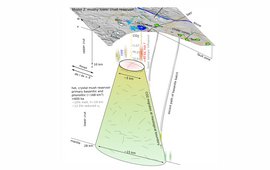Past projects
Multi-risk assessment and cascading effects analysis conducted as part of a cooperation between Indonesia and Germany - Joint research on tsunamis induced by volcanoes and landslides.
The potential of deep geothermal energy in Europe will only be exploited in the future if demonstrations of energy production from deep geothermal energy are successful. lt is therefore crucial that a procedure is implemented before drilling the next deep well, which minimizes the risk of field exploration.
The management of the post mining regions in Europe is important issue for the safety and economic reasons. The PostMineQuake traits the most important hazard related to unexpected ground motion.
This project aims at developing a physics-based tool to forecast the location and time of a fissure eruption following magma propagation below the surface.
Early-Warning and Rapid Impact Assessment with Real-time GNSS in the Mediterranean
One major unresolved questions in magmatic geodynamics is the physical understanding of the complete sequence of melt ascent from the asthenospheric depth to shallow intrusions (crustal dykes): The physics of melt ascent within the asthenospher is usually described by two-phase flow of melt within a rock matrix.
NEWTON-g aims at developing a field-compatible gravity imager to constrain movements of subsurface fluids through collecting continuous images of the gravity field.
The aim of this project is to obtain a conceptual model of deep fluid pathways (both ancient magmatism and the modern hydrothermal system related to magma stored at depth) in the Eger Graben and the Cheb basin.
VOLCAPSE is a ERC consolidator project awared to the T. R. Walter and his volcanotectonics group and volcano hazards group at the GFZ Potsdam, studying modes of volcano dome growth, collapse and coupled process by time-lapse imaging methods.
The project aims to investigate the processes which control the multi-scale seismicity of the Alps. We hypothesize that patterns of stress and motion can be quantified from the seismicity which is observed with unprecedented resolution by AlpArray. The observed seismicity will illuminate the structure of faults and their kinematics at depth, providing an important and unique link between surface deformation and deep processes.
In this project, we will reveal how a volcano’s shape (e.g. stratovolcano vs. caldera) and growth history influences the depth and construction of magma storage.
The European Plate Observing System (EPOS) aims at creating a pan-‐European infrastructure for solid Earth science to support a safe and sustainable society. The mission of EPOS is to integrate the diverse and advanced European Research Infrastructures for solid Earth Science relying on new e‐science opportunities to monitor and unravel the dynamic and complex Earth System such as earthquakes and volcanic eruptions.
The HGF Alliance “Remote Sensing and Earth System Dynamics” aims at the development and evaluation of novel bio/geo-physical information products derived from data acquired by a new generation of remote sensing satellites.
HISS is an innovative project to develop and apply new approaches for double difference attenuation tomography to NW Bohemia earthquake swarm regions. The project aims to improve the understanding of the processes of development and formation of mid crustal magmatic reservoirs, their dynamics and associated geothermal systems.
The SHEER EU H2020 project addresses the topic LCE-16-2014: Understanding, preventing and mitigating the potential environmental impacts and risks of Shale Gas Exploration and Exploitation.
The project aims at the understanding and modelling of an unusual seismic activity under Halmahera (NE Indonesia).

![[Translate to English:] ERC RottnRock Logo](/fileadmin/_processed_/6/a/csm_ERC_logo_19cd8fc455.jpeg)
![[Translate to English:] Logo Multimarex](/fileadmin/_processed_/4/e/csm_Multimarex_Logo_1_48fe386373.jpeg)
![[Translate to English:] Erkundung und Förderung von Ressourcen in neuen Gebieten ist ein risikoreiches Unterfangen,](/fileadmin/_processed_/2/3/csm_Projekt_Degree_b6d63db0b7.jpeg)
![[Translate to English:] [Translate to English:] Abbildung](/fileadmin/_processed_/8/8/csm_Figure_Chasing_78f810c8be.jpeg)
![[Translate to English:] [Translate to English:] Seismische Stationen in der Eifel](/fileadmin/_processed_/8/9/csm_Overview-stations-closeup_30mar2022_6e6b3beb6e.png)
![[Translate to English:] [Translate to English:] Impressionen von der 400 m tiefen Bohrung in Landwüst](/fileadmin/_processed_/0/5/csm_icdp-EGER_bca3138f08.jpeg)